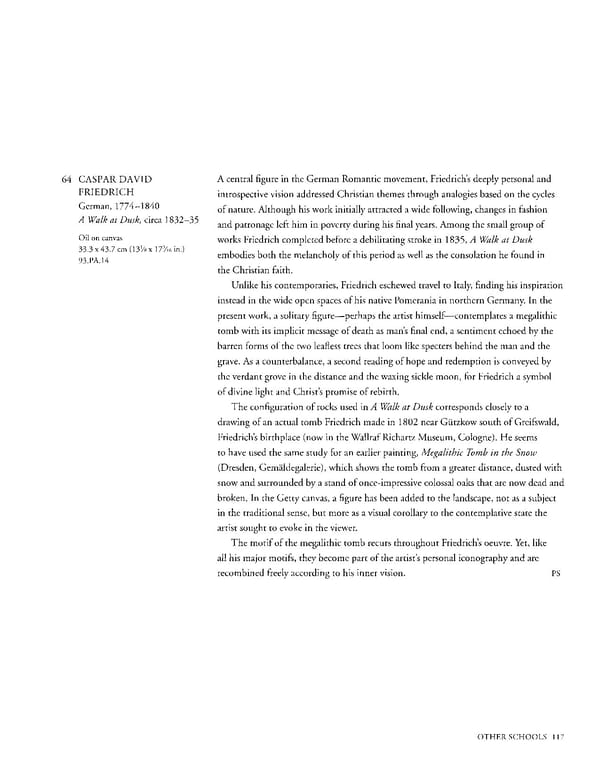64 CASPAR DAVID A central figure in the German Romantic movement, Friedrich's deeply personal and FRIEDRICH introspective vision addressed Christian themes through analogies based on the cycles German, 17741840 of nature. Although his work initially attracted a wide following, changes in fashion A Walk at Dusk, circa 183235 and patronage left him in poverty during his final years. Among the small group of Oil on canvas works Friedrich completed before a debilitating stroke in 1835, A Walk at Dusk 33.3 x 43.7 cm (13 x 17 3/16 in.) embodies both the melancholy of this period as well as the consolation he found in 93.PA.14 the Christian faith. Unlike his contemporaries, Friedrich eschewed travel to Italy, finding his inspiration instead in the wide open spaces of his native Pomerania in northern Germany. In the present work, a solitary figure—perhaps the artist himself—contemplates a megalithic tomb with its implicit message of death as man's final end, a sentiment echoed by the barren forms of the two leafless trees that loom like specters behind the man and the grave. As a counterbalance, a second reading of hope and redemption is conveyed by the verdant grove in the distance and the waxing sickle moon, for Friedrich a symbol of divine light and Christ's promise of rebirth. The configuration of rocks used in A Walk at Dusk corresponds closely to a drawing of an actual tomb Friedrich made in 1802 near Gutzkow south of Greifswald, Friedrich's birthplace (now in the Wallraf Richartz Museum, Cologne). He seems to have used the same study for an earlier painting, Megalithic Tomb in the Snow (Dresden, Gemaldegalerie), which shows the tomb from a greater distance, dusted with snow and surrounded by a stand of onceimpressive colossal oaks that are now dead and broken. In the Getty canvas, a figure has been added to the landscape, not as a subject in the traditional sense, but more as a visual corollary to the contemplative state the artist sought to evoke in the viewer. The motif of the megalithic tomb recurs throughout Friedrich's oeuvre. Yet, like all his major motifs, they become part of the artist's personal iconography and are recombined freely according to his inner vision. PS OTHER SCHOOLS 117
 Masterpieces of the Getty Museum: Paintings Page 117 Page 119
Masterpieces of the Getty Museum: Paintings Page 117 Page 119